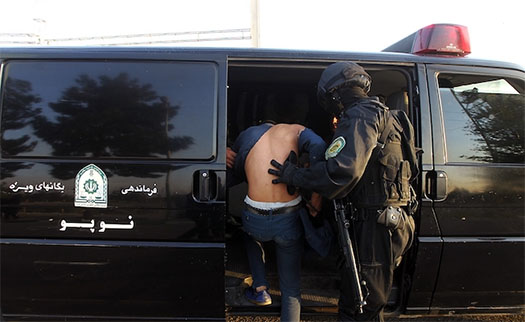
“They arrested him and then they beat and killed him. Now they want to destroy his reputation.”
January 11, 2018—CHRI – Iran should launch an independent investigation of the cases of two detainees who died in custody, allegedly by suicide, after being arrested during the recent protests in Iran. The results of the investigations should be shared with the public at every stage of the process with full transparency.
“There are serious questions surrounding these protesters’ deaths,” said Hadi Ghaemi, the executive director of the Center for Human Rights in Iran (CHRI).
“After protesters died in custody at the Kahrizak Detention Center in 2009, the authorities claimed suicide then too, but in the end they could not deny that the victims died as a result of torture and Kahrizak’s inhumane conditions,” added Ghaemi.
Twenty-three-year-old Sina Ghanbari died in custody in Tehran under unknown circumstances on January 7, 2018. The authorities claimed he killed himself in Evin Prison.
Twenty-two-year old Mohammad Heydari died in detention at the 12th Police Station in Arak sometime between the end of December 2017 and the beginning of January 2018. His lawyer told CHRI the authorities are trying to cover-up the real reason for his death by claiming he committed suicide.
“I believe that this young man did not take his own life,” Najafi told CHRI on January 8, 2018.
“This young man was a protester,” said Mohammad Najafi, who works in the city of Arak where Heydari was arrested on December 31, 2017. “They arrested him and then they beat and killed him. Now they want to destroy his reputation.”
Ali Bagheri, a civil rights activist based in Arak, told CHRI that one of Heydari’s relatives told him they had seen evidence of a severe blow to Heydari’s skull before his body was buried. Heydari’s family has been pressured to avoid speaking to the media.
“One of his relatives who had seen his body told me that there was a deep gash on the top of the left side of his head,” said Bagheri. “It was as if he had been struck with an axe. Nobody commits suicide like this.”
“They killed him and then they warned his family not to speak to anyone or the media,” he added. “There was a heavy security presence at his funeral.”
CHRI calls on the Iranian authorities to stop the intimidation and attempted silencing of the families of those who have died in detention and on the streets, and to refrain from smearing the victims in an attempt to influence public opinion.
At least 25 people have been killed since anti-government demonstrations broke out across Iran on December 28, 2017. The protests have been harshly repressed by the authorities and thousands are being held without charge.
CHRI also calls for the release of the more than 3,700 demonstrators who have been detained, many without charge, since the protests broke out.
No Official Medical Report on Heydari’s Cause of Death
Heydari was street peddling in one of Arak’s main squares when he joined a protest on December 31, 2017. He was detained at the 12th Police Station and on January 6, 2018, security agents ordered his burial in section 34 of Arak’s Behesht Zahra Cemetery.
The authorities immediately claimed Heydari committed suicide but the medical examiner has not yet issued a report on the cause of his death.
The authorities also claimed Heydari was a drug addict who had 10 grams of heroin in his possession at the time of his arrest, a claim his family has strongly denied.
On January 10, Central Province Prosecutor Abbas Ghassemi confirmed that one person had died in detention in Arak, the provincial capital, but did not mention Heydari by name.
“There were definite signs of self-beating on this individual. There is also a film showing the moment he committed suicide. Therefore, the evidence confirms that his death was caused by suicide,” Ghassemi told Mizan, the judiciary’s official news agency.
Heydari’s lawyer told CHRI that other detainees had reported being beaten at the station where Heydari died.
“On the first day of protests in Arak on December 30, there were no street confrontations. But on the second day, it dragged into a little bit of tension and confrontation. Vahid Heydari was arrested on this day,” said Najafi, who had offered his services pro bono to Heydari’s family.
“We have received reports of cases of people who were beaten at that police station during this period,” he added. “We have also visited Heydari’s village near Arak and spoke to his family and associates who have denied he was ever an addict or sold drugs. They are very upset.”
Several members of Heydari’s family are known in their village as “martyrs” of the Iran-Iraq War (1980-88) and his father is a disabled veteran of the conflict.
The civil rights activist who spoke with CHRI also visited Heydari’s birthplace, the village of Takiyeh, and spoke to several villagers about Heydari’s death.
“Everyone says he died from blows from a baton in detention,” said Bagheri. “The police are denying that and are saying he was arrested for carrying drugs and committed suicide in detention.”
“But his family says he was a very honorable man and that the accusations don’t stick,” he added. “He did not use or sell drugs.”
“We still don’t know what happened to Vahid,” one of Heydari’s relatives told CHRI on condition of anonymity for fear of reprisals. “We were in the village and he was in Arak. He was busy working. He was not an addict. What they are saying about him is untrue.”
Ghaemi said the Iranian government should allow an independent investigation of Heydari and Ghanbari’s deaths.
“If these protesters’ deaths were not caused by the authorities or conditions at the facilities where they were held, then the judiciary and state officials have no reason to impede an independent investigation,” he noted.
